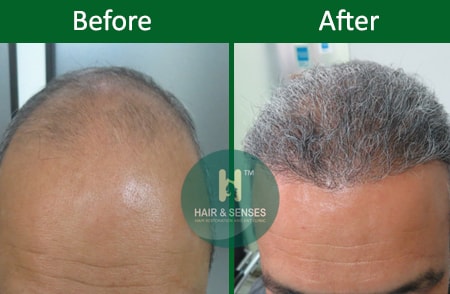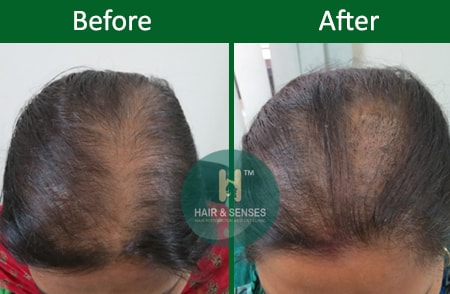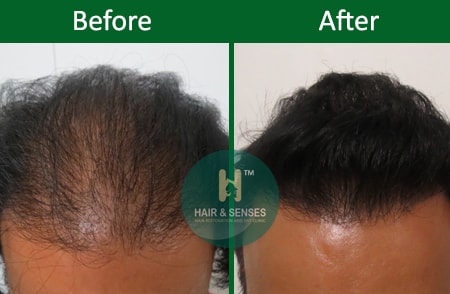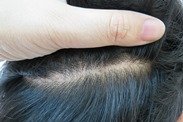FUE hair transplant in Delhi is one of the techniques for extracting the follicles from the donor area, the other technique being FUT. This technique has increased the spectrum of surgeries done in hair transplant procedures. With this technique, grafts from other body areas like the beard, upper chest, and upper back are possible, so a body-to-scalp hair transplant can be done.
This technique has evolved over some time and has reached to present day and it is very difficult to make out whether one has undergone a hair transplant. The grafts are extracted using the micro punch so the area of the follicle which is inside the skin is not directly visible, so one needs a good understanding of the hair anatomy and also a good experience to achieve a very low graft transection rate. The direction and the angle of the follicle may change on coming out of the skin posing a challenge for the surgeon. So, the surgeon must use proper magnification and illumination so that the orientation of the naturally emerging hair can be properly observed and the punch can be properly placed over them. This will avoid unnecessary transactions and will reduce the chances of improper grafts thereby ensuring good results.

- Candidacy for FUE Hair Transplant:
- The patient has male pattern baldness, generally more than Norwood stage2.
- The patients who want to have short haircuts.
- Repair or correction of previously done surgery.
- Patients who may require the body for a scalp hair transplant.
- Who have already undergone a FUT hair transplant and have tight scalps.
- To cover the scar from previous surgery, injury, or burn.
FUE Hair Transplant Procedure
After all the initial check-ups and paperwork, the patient is given pre-medication. Once the hypersensitivity to drugs is checked, the patient is taken to the procedure room after changing into an OT dress.
Local anesthesia It blocks the pain and makes the area numb where it is given. It is infiltrated into the scalp or any area where one needs to do the procedure. One can use topical cream sometimes before the injections so that the prick of the injections is also not fully felt.
Making of the recipient slits: Recipient slits are the spaces made by the doctor keeping in mind the direction and angle of the natural existing hair in that region. The density of the transplanted hair also depends on this stage of the surgery. It is very important that the operating doctor has a good amount of experience in the procedure otherwise whole procedure may become a problem.
Graft extraction: Extraction of grafts is done in a way so that quality grafts are harvested. This is the step where the experience of the doctor counts as only an expert can harvest grafts without much wastage and without transection.
Implanting the grafts: The harvested grafts are placed in the slits which were made by the doctor. The key is delicate handling of the grafts while placing them.
What are Recipient sites and How these recipient sites are created?
These are numerous small incisions, which are created by surgeons in the area of hair loss where the extracted donor grafts are then placed.
The outcome of a hair transplant significantly depends on how these recipient sites are created.
The recipient sites are made in such a way that the transplanted hair grows in the same direction and angle as that of the existing natural hair. The spacing and the size of the slit should be such that the graft should not pop out and the graft should fit in properly to ensure good nutritional and oxygen supply to the transplanted follicle.
We at Hair & Senses generally make lateral slit (horizontal slits) as this provide better coverage and also have proper control over the angle at which the hair will grow. With lateral slit, acute angulations, which are required in the crown and temporal region, can be better achieved.
Preparation of Donor area in FUE hair transplant
The area from where grafts/ follicles are harvested to be transplanted to the area of baldness is called the donor area. The primary site of the donor area is the back and sides of the scalp as the hair roots in this area are not prone to the effect of DHT. But when the scalp donor area is not sufficient then other areas like the beard and upper chest can be used as donor areas in FUE Hair Transplant.
In the case of the scalp being used as a donor, the area is shaved by one of our team members depending on the number of grafts needed. The shaving is done mainly using the ‘0’ number trimmer setting.
In the case of the beard being also used as a donor area then the patient is asked not to shave the beard for 3 days before the procedure and for the chest, the shaving should not be done for at least 4-5 days by the patient so that proper visualization and extraction of the donor grafts can be done. The trimming of the area is done at our center according to the need.
After the patient is taken into the procedure room, the area is cleaned with an antiseptic solution, and the area is anesthetized by infiltrating with local anesthesia. Then the extraction is done by using small punches of around 0.8mm or 0.9mm punches and still finer punches for the beard and chest area. During the extraction, we particularly take care that it is done randomly and diffusely to avoid over-harvesting in one particular area. Dr. Sangay takes special care to avoid transactions and hence graft wastage during the donor harvesting process.
Points to remember while placing the grafts
Graft placements are one of the crucial steps in hair transplant surgery which directly affects the result of the procedure.
One of the common problems is desiccation and dehydration of the grafts. So this should be avoided by placing the grafts in saline/ ringer lactate solution or other holding solution and by taking a limited number of grafts while placing.
The angle of exit of the hair from the scalp should be kept in mind and the grafts are placed to achieve this proper orientation and angulation.
Another problem while placing the grafts is popping out of grafts. Achieving the proper depth and creating a recipient site with proper spacing decrease the chances of graft popping out. The recipient site which is made too close to each other and where the sites are shallow increase the chances of graft pop-outs.
Advantages of FUE Hair Transplant:- No incision so no stitches
- No linear scar
- Less discomfort postoperatively
- Faster Healing
- Return to normal routine early
- Body-to-scalp hair transplant can be done through this
Cost of FUE hair transplantFUE Hair Transplant has become popular among patients as it allows early healing and also has the freedom of styling hair even if they want to sport short hair. As this is technically an advanced procedure so it is comparatively expensive in comparison to the FUT procedure.
The cost mainly depends on:
- The skill and experience of the doctor: FUE hair transplant is majorly dependent on the doctor as in every step of the surgery doctor plays a key role be it recipient slits creation, extraction of the follicle, or the placement of the graft follicles. So the experience of the doctor is one of the factors that play a part in deciding the cost.
- Infrastructure of the center: The infrastructure of the place including the instruments used, hygiene protocols, and proper set up all add to the cost of the procedure.
- Number of grafts to be transplanted: The cost majorly depends on the number of grafts to be transplanted. At our center, we count only the high-quality grafts that are transplanted. This counting is done at every step counting is done when slits are made, and counting is when grafts are extracted. These grafts are then examined and only good-quality grafts are transplanted.
- Repair procedure: This also contributes to the cost significantly. The repair transplant requires an experienced surgeon who can handle these situations correctly. So these are technically more demanding.
Frequently Asked Questions about FUE Hair Transplant• Is a FUE hair transplant right for you?
• Can FUE hair transplant be done with less donor area?
Are there any risks or side effects of FUE Hair Transplant?The complications or side effects are very less and not so commonly encountered.
Common complaints after surgery:
These are the common general problems that are experienced by patients after the FUE hair transplant. These can be considered more or less like a sequel of the procedure.
Pain: This is generally not a problem and can be easily taken care of by analgesics or painkillers.
Bleeding: Minimal bleeding may occur after hair transplant and this is more common in donor. Applying firm pressure using sterile cotton or a gauze piece is enough to control the bleeding.
Swelling on the forehead: It generally manifests after 3-5 days of the surgery and subsides within 5-7 days. Sleeping or resting with a slight head-up position may help in reducing the swelling. Gentle forehead massage and applying cold packs may also help in decreasing swelling.
Itching: One may require antihistaminics or sometimes steroid cream may also help in reducing the itching.
Numbness of the scalp: This generally takes around 2-3 months to go away.
A complication that occurs in the donor area:
Visible scarring: In FUE hair transplant problematic visible scarring occurs when over-harvesting is done otherwise only tiny dots are there which are generally unnoticeable. Overharvesting is generally not a problem in skilled and experienced hands.
Donor effluvium or shedding in donor area: It occurs after 6 weeks of the procedure and is like a diffuse hair loss in an FUE hair transplant. This generally resolves on its own in 3-4 months but the application of minoxidil may help.
Buried grafts: This occur if improper punches are used and if the alignment of the punch is not along the graft.
Complications that occur in the recipient area:
Folliculitis: This may need antibiotic ointment and may require antibiotics for 5-7 days to subside.
Poor density: This can occur due to poor graft survival or due to improper graft distribution.
Poor hairline: This may be due to poor design and may be due to poor angulation of the grafts that are placed.
Cobblestoning: when the grafts are placed at improper depth
What to expect after an FUE hair transplant?FUE hair transplant is a procedure that has now gained much popularity in regard to hair transplant owing to its potential advantages. These help the patients to resume work early as this has a faster healing time. Healing of the donor area generally is achieved in 5-7 days
Once the transplant is done using the FUE technique, there will antiseptic dressing and bandage on the scalp. This will be removed after 48 hours and the first head wash will be given at the clinic itself. All the necessary instructions about the subsequent head wash will be explained by the doctor. We prefer to clean the scabs at our clinic after 10 days of surgery but if the patient is not in the station then all the instructions are given regarding how to gently rub the scabs and remove them without damaging the transplanted grafts. There may be some swelling in the forehead which generally subsides in 3-5 days.
In the postoperative period patients generally experience shedding that may start 3-4 weeks after the procedure and may continue for 3 months. The hair growth starts from around the 4th month onwards and full results are achieved in 10-12 months depending on patient to patient
Why Hair & Senses for FUE hair transplant?• Hair & Senses has a team of well-experienced and highly skilled doctors with highly experienced and professional staff.
• Detailed consultation and clinical examination is done by the doctor so that proper assessment and diagnosis can be reached.
• We do proper planning for each and every patient keeping in mind about the patient's age, hair characteristics, and availability of donor grafts.
• Proper strategy is made regarding the distribution of the grafts over the recipient area.
• Experience at Hair & Senses is essentially pain-free, comfortable, smooth, coordinated, and hassle-free.
• All the essential steps like infiltrating local anesthesia, making the recipient slits, and extraction of the grafts are done by the doctor itself with some support from her team, and graft placement is done by the doctor with her highly trained team
• We have a minimal transaction rate.
• At Hair & Senses, we follow all the standard sterilization and disinfection protocols so the chances of infection are minimal and one does not have to worry about hygiene and cleanliness.
• We are always there for our patients in this journey of hair transplant giving and reminding them about the dos and don’ts after the procedure and answering any queries of the patients.
We invite you to browse through our website to learn more about our practice. Feel free to contact us with any questions you may have about Hair Transplant or Hair & Senses or if you would like to Schedule an appointment!
Source - https://hairnsenses.co.in/FUE-Hair-Transplant.php

.jpg)



.jpg)
.jpg)
